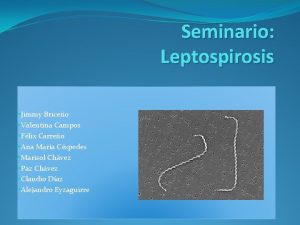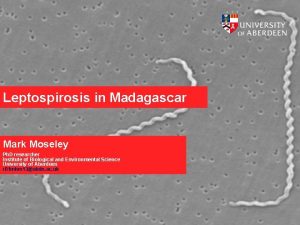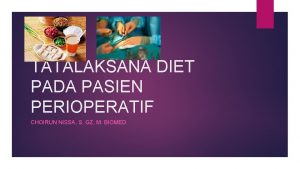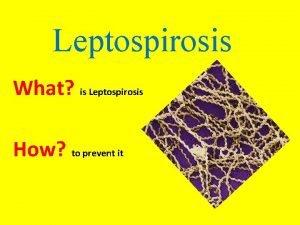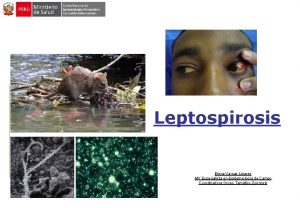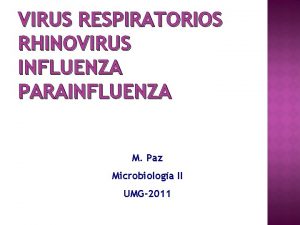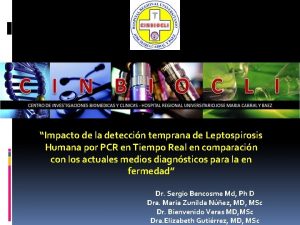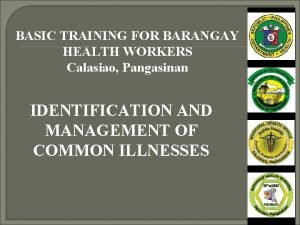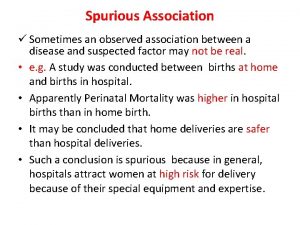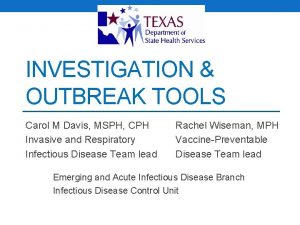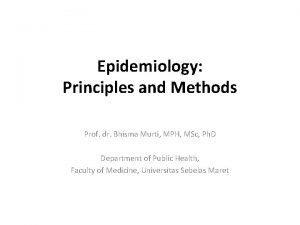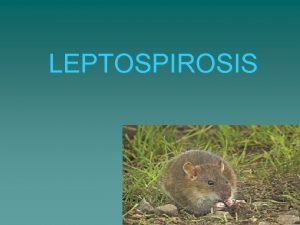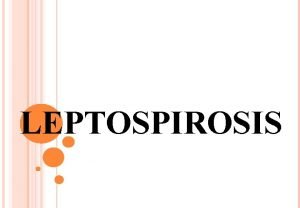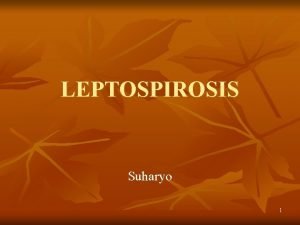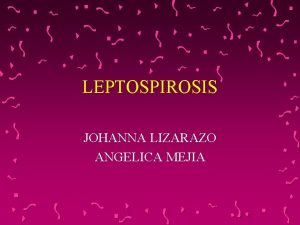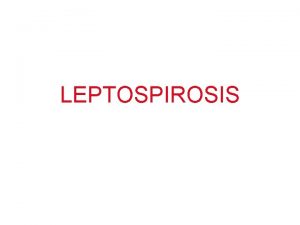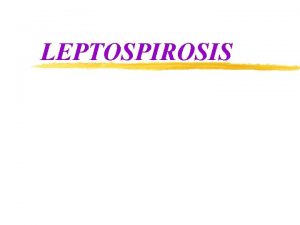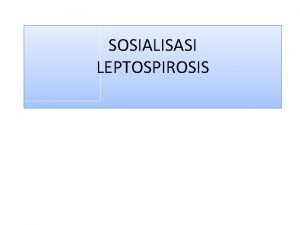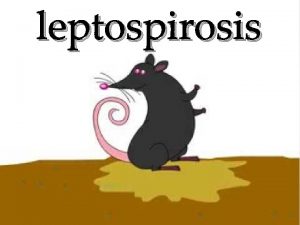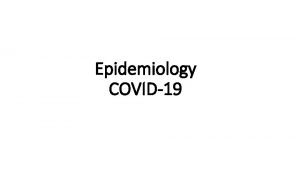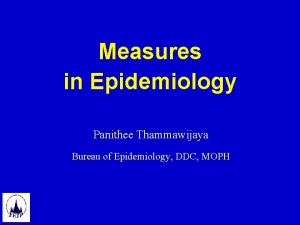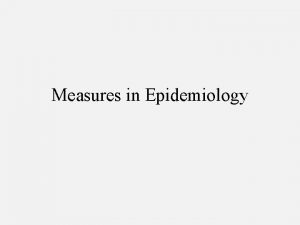EPIDEMIOLOGY OF LEPTOSPIROSIS CONTROL MEASURES Dr I Selvaraj

































- Slides: 33

EPIDEMIOLOGY OF LEPTOSPIROSIS & CONTROL MEASURES Dr. I. Selvaraj

• Leptospirosis is an acute anthropozoonotic infection • It occurs in tropical, subtropical and temperate zones. • Weil Disease, Hemorrhagic Jaundice, Mud Fever, Swineherd Disease, Canicola Fever, seven-day fever found commonly in Japan, Cane cutter’s disease in Australia, Rice field Leptospirosis in Indonesia , Fort Bragg fever in U. S. Andaman haemorrhagic fever(AHF)

L 2 - Endemic Locations where the infection is commonplace, caused by high rainfall, close human contact with livestock or wild animals, poor sanitation or workplace exposure (rice farming, etc). Example countries in class L 2 are India, Central America and certain areas of the Pacific Rim. L 1 - General Locations where the infection is at the international average of 0. 05 cases per 100, 000, and infection is usually the result of accidental exposure through wild rats, livestock or direct contact with water through leisure or occupation. Example countries in class L 1 are North America, Europe, Australia and the former Soviet territories.

• 1883 it was recognized as an occupational disease of sewer workers • 1886 first description (by Weil, Professor of Medicine at Heidelberg (1886) ) of the clinical manifestations seen in men (severe jaundice, fever, and hemorrhage with renal involvement) • 1907 - Stimson described the lesion in the renal tubules who died of so called yellow fever. • 1916 the causal agent was identified by Inada in Japan • Noguchi proposed the name ‘Leptospira’ (thin spirals) in 1918

SERO POSITIVITY RATE - INDIA • • • 2000 -2001 – 0 to 46. 8% S. India – 25. 6% N. India – 8. 3% W. India – 3. 5% E. India – 3. 1% &C. India – 3. 3%

INDIA • The first of its kind in India was reported in the 1920 s from Andaman and Nicobar Islands. • In 1993, a serosurvey of conservancy workers in Madras (using MAT) revealed a prevalence rate of 32. 9%. • In 1994, an increase in the number of individuals with uveitis was noted at Aravind Eye hospital, Madurai, India after an epidemic of leptospirosis in South India; the epidemic followed severe flooding of the Tamil Nadu District in the autumn of 1993 • In 1995, a seroprevalence rate of 12% leptospirosis was found among febrile and jaundice patients in Pondicherry

LEPTOSPIROSIS IN INDIA In 1905, Chowdry presented 585 cases of the disease in the Andaman islands, calling it "malaria with jaundice". In the Andamans, this disease was also called as "Andaman haemorrhagic fever" with a predominance of haemorrhagic signs. In Kerala, it was the same type as seen in the Andamans. In Chennai city, the most severe form was jaundice and a haemorrhagic type. Of late, eye disorders as late complications of leptospirosis have been recorded in Madurai. Cardiac arrhythmias in Mysore are the latest reports on the manifestations of the disease.

Classification: • • • Phylum: Spirochaetes Class: Spirochaetes Order: Spirochaetales Species: Leptospira Family: Leptospiraceae

• The genera Leptospira contains three species, namely L interrogans, L biflexa and L parva. The first includes 23 serogroups and more than 250 serovars and is the principal cause of leptospirosis in humans and animals. most common being L. canicola, L. hardjo and L. hebdomadis. • Two types of leptospirosis: 1. Anicteric leptospirosis or self-limited illness (85% to 90% of the cases) 2. Icteric leptospirosisor weil’s syndrome (5% to 10% )

• The etiologic agent of leptospirosis is Leptospira interrogans. • It is a thin spiral organism 0. 1 mm x 6 - 20 mm, with tightly set coils • It is characterized by very active motility, by rotating (“spinning”) and bending. Usually one or both ends of this single-cell organism are bent or hooked • Because of their narrow diameter, the leptospires are best visualized by dark-field illumination or phase contrast microscopy and they do not stain readily with aniline dyes.

• A microscopic view of Leptospira. I bacteria stained apple green with a fluorescent dye (from the CDC’s Public Health Image Library)

Reservoirs Wild and domestic animals rodents, livestock (cattle, horses, sheep, goats, swine), canines, and wild mammals are the reservoir for leptospirosis. Many animals have prolonged leptospiruria without suffering from the disease themselves.

Modes of Transmission • By direct or indirect contact of nasal, or eye mucosal membranes or abraded or traumatized skin with urine or carcasses of infected animals. • Urine: Indirect exposure through water, soil, or foods contaminated by urine from infected animals is the most common route. After a short period of circulating high levels of the spirochete in their blood, animals shed the spirochete in their urine, contaminating the environment. • Inhalation of droplet aerosols of contaminated fluids can occasionally occur.

• Incubation period • The incubation period is usually 2 -26 days, but usually (7 – 12 days) days. • Period of Communicability or Infectious Period Humans with leptospirosis usually excrete the organism in the urine for 4 -6 weeks and occasionally for as long as 18 weeks. • Person-to-person transmission is considered extremely rare.

1. Cases are seen sporadically throughout the year. But an outbreak occurs during the rainy season because of widespread contamination by infected rodent urine in flood water. 2. Rodents are displaced from their burrows and drains by the water. 3. High humidity and heavy rainfall intensify the outbreak. 4. Rats and bandicoots distribute more virulent leptospires through their urine into the environment than other animals.

COMPLICATIONS • • Azotemia Oliguria Hemorrhage Purpura Hemolysis Gastrointestinal bleeding Hypoprothrombinemia and Thrombocytopenia

Differential diagnosis • • • Influenza Meningitis (encephalitis) Viral hepatitis Rickettsiosis Typhoid fever Septicemia Toxoplasmosis Legionnaire’s disease If with jaundice during or after an acute febrile illness, • Malaria, septicemia, alcoholic hepatitis and typhoid fever

Direct Evidence • Demonstration of leptospires or their products: • Microscopy • Dark-field microscopy • Phase contrast microscopy

Indirect Evidence Detection of antibodies to leptospira: • • • Macroscopic agglutination test (MSAT) Indirect fluorescent antibody test (IFAT) Indirect haemagglutination test (IHA) Counter immuno electrophoresis (CIEP) Complement fixation test (CFT) Newer techniques ELISA Microcapsule agglutination test (MCAT) Lepto-Dipstick Serogroup/serovar specific tests Microscopic agglutination test (MAT) Serovar specific ELISA

• Demonstration of a rise in antibody levels either through MAT or ELISA is essential by repeating the sampling at least four days after taking the first sample. • In Chennai, the MAT test is available at the Veterinary University, Madhvaram, the MGR Medical University, Guindy and the microbiology department of the Madras Medical College. • The Ig. M dip stick ELISA is commercially available from Organon Teknika (Infar India) and Pan Bio (Australia). Using this test could help detect leptospirosis during the acute (early) phase of the illness.



TREATMENT • Penicillin 6 million units daily I. V (10 -14 days) • Amoxycillin, Erythromycin, & Doxycycline • Patients with MOF(Multi organ failure) to be observed and treated in intensive care unit

PREVENTION Environmental Measures • To prevent illness, prevent contamination of living, working and recreational areas by urine of infected animals. • • Control rodent populations in areas of human habitation. • • Domestic animal owners should take necessary precautions to minimize their animal’s potential • contact with wildlife ( e. g. , do not feed pets outside or allow animals to roam unsupervised). • • Do not allow animals to urinate in or near ponds or pools. • • Keep animals away from gardens, playgrounds, sandboxes, and other places children may play. • • Among domesticated animals, vaccination of swine, cattle, and dogs. Cont…

• Chlorination is seldom useful, as virulent leptospires withstand up to 4 ppm in potable water. • Filtered water is not safe. • Using boiled or ultraviolet irradiated water is advisable. • Water tanks must be sealed if possible. • Food articles must be stored in properly fitting containers. • Bathroom and kitchen waste pipes must be blocked at night. • Try avoiding walking in flood water. If you have to, wear gum boots. • Heavy drinking and smoking predispose damage to the liver and the kidneys which in turn become vulnerable to leptospiral infection.

PREVENTION • Protected water supply to all. • Proper collection, transport, treatment and secured disposal of garbage. • Drinking boiled water. • Disinfections of contaminated work areas. • Providing proper protective clothing, shoes, gloves, etc. to high-risk Occupational groups.

Disinfection • Leptospira species can be inactivated by 1%sodium hypochlorite • 70%ethanol, • glutaraldehyde, • formaldehyde, • detergents and acid. • This organism is sensitive to moist heat (121 ° C for a minimum of 15 min))and is also killed by pasteurization.

HIGH RISK GROUPS 1. DAIRY FARMERS AND MILKERS 2. SLAUGHTER-HOUSE WORKERS 3. MEAT INSPECTORS 4. VETERINARIANS AND MEAT CARRIERS IN FOOD INDUSTRIES 5. PEOPLE WHO WORK HABITUALLY IN WET OCCUPATIONS (RICE FARMERS, SUGAR CANE HARVESTERS, DRAINERS, SEWER WORKERS, MINERS) 6. ADVENTURE TRAVELLERS (CAVE EXPLORATION, WHITE WATER RAFTING, WATER SPORTS) 7. AND MILITARY OR CIVIL EMERGENCY PERSONNEL.

All the people involved in high-risk activities should wear protective clothing and need to adopt a reasonable standard of hygiene. Impervious knee-high boots, aprons, gloves, face masks or eye protection should be used wherever indicated. Immunization of high risk groups (USSR, CHINA, ITALY) Chemo prophylaxis: Doxycycline can prevent leptospirosis, if given before and during exposure.

In the ICD 10 disease classification system, leptospirosis is code A 27.

The International Leptospirosis Society (ILS) was formed in 1994 to promote knowledge on leptospirosis through the organisation of regional and global leptospirosis meetings.

REFERNCE Leptospirosis in India and the Rest of the World Rao R. Sambasiva, Gupta Naveen, Bhalla P. and Agarwal S. K - Nursing Journal of India, Jul 2002 by Xavier, Shalini - Leptospirosis – An overview by TK Dutta, M. Christopher (JAPI. VOL. 53. JUNE 2005) -k. park 18 th edition

THANK YOU
 Henry selvaraj
Henry selvaraj The open group architecture framework
The open group architecture framework Perbedaan or rr dan pr
Perbedaan or rr dan pr Diagnostico de leptospirosis
Diagnostico de leptospirosis Leptospirosis
Leptospirosis Leptospirosis ncp
Leptospirosis ncp Leptospirosis
Leptospirosis Leptospirosis
Leptospirosis Fluviatol
Fluviatol Leptospirosis complicaciones
Leptospirosis complicaciones Basic training for barangay health workers
Basic training for barangay health workers Cbic recertification
Cbic recertification Anova repeated measures
Anova repeated measures Advantages and disadvantages of nutritional epidemiology
Advantages and disadvantages of nutritional epidemiology Logistic regression epidemiology
Logistic regression epidemiology Prevalence calculation formula
Prevalence calculation formula Ecological study design
Ecological study design Attack rate epidemiology formula
Attack rate epidemiology formula Difference between descriptive and analytic epidemiology
Difference between descriptive and analytic epidemiology Person place time epidemiology
Person place time epidemiology Difference between descriptive and analytical epidemiology
Difference between descriptive and analytical epidemiology Prevalence vs incidence
Prevalence vs incidence Bibliography of epidemiology
Bibliography of epidemiology Causal vs association
Causal vs association Formula for attack rate
Formula for attack rate Gate frame epidemiology
Gate frame epidemiology Model of disease causation
Model of disease causation فاطمة خليفة
فاطمة خليفة Defination of epidemiology
Defination of epidemiology Endemic definition in community health nursing
Endemic definition in community health nursing What is descriptive study in epidemiology
What is descriptive study in epidemiology Spurious association in epidemiology
Spurious association in epidemiology Field epidemiology ppt
Field epidemiology ppt Bhisma murti
Bhisma murti



